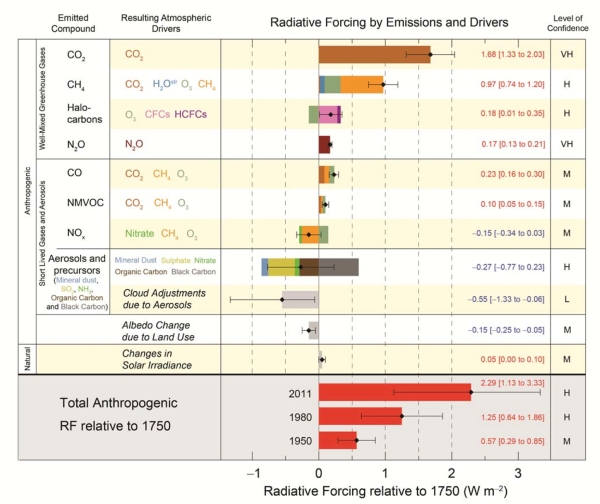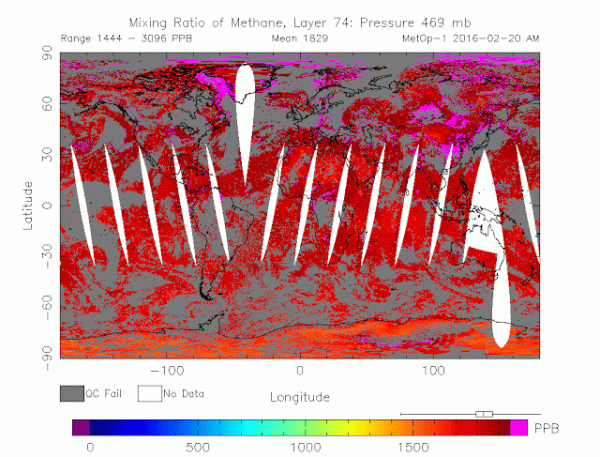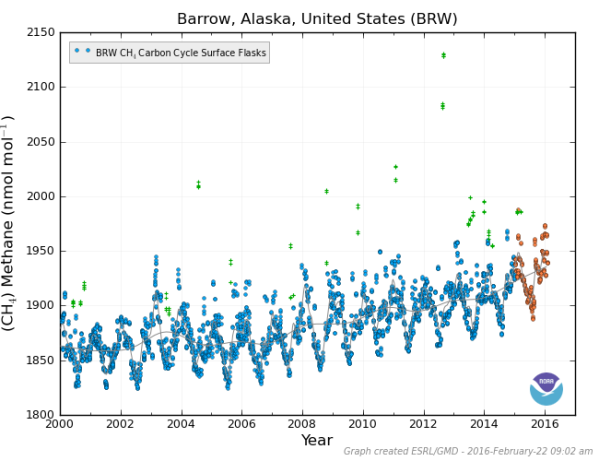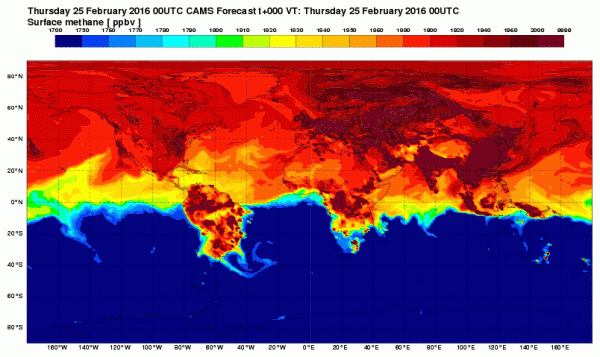Robertscribble makes a relatively rare reference to methane being fairly conservative about the clatrate gun
2 C Coming On Faster Than We Feared — Atmospheric Methane Spikes to Record 3096 Parts Per Billion
26
February, 2016
It’s
essential that policymakers begin to seriously consider the
possibility of a substantial permafrost carbon feedback to global
warming. If they don’t, I suspect that down the road we’ll all be
looking at the 2°C threshold in our rear-view mirror.
****
Unraveling
the global warming puzzle is simple at its face, complex when you
pierce the surface.
We
know that burning fossil fuels, that the activity of mining coal,
fracking for gas, and drilling for oil all result in dangerous
greenhouse gas emissions. We know that the vast majority of these
warming gasses are coming from fossil fuel based sources. We know
that, now, the burning and mining and fracking and drilling have
pushed atmospheric CO2 above 405 parts per million and the global
concentration of all CO2 equivalent gasses to an amazing 485 parts
per million CO2e (levels not seen in at least 15 million years). And
we know that the heat re-radiated by these gasses has warmed the
world by about 1 C above 1880s levels — forcing weather patterns to
change, seas to rise, ocean health to decline, and setting off a wave
of die offs in the animal world while increasing the near-term risk
of hunger, spreading tropical disease, and mass displacement in the
human world.
(Heat
added to the Earth’s atmosphere by fossil fuel emitted gasses like
CO2 and Methane are measured in watts per meter squared. A yardstick
known as radiative forcing [RF]. In the above graph by IPCC, we can
see the estimated levels of radiative forcing from each greenhouse
gas and total net human heat forcing upon the Earth atmosphere as of
2011. It’s a measure that may also need to start adding in the RF
of feedback greenhouse gasses as the 21st Century progresses. Image
source: RealClimate.)
We
know many of the names of these other gasses — methane, nitrous
oxide, and chlorofluorocarbon. And some of the others — like sulfur
hexaflouride — many of us haven’t yet heard of. But
the big name, the primary warming agent, is carbon dioxide —
responsible on its own for the majority of the overall heat forcing
currently. A gas so important to long term warming that NASA has
called it ‘the
thermostat that controls Earth’s temperature.’
All
this is pretty simple and straightforward. But it’s when we start
looking at what are called amplifying feedbacks — the Earth System
Sensitivity responses to human forced warming — that things really
start to get dicey. And wrapped up in the Earth System Sensitivity
equation is methane — a greenhouse gas with the ability to strongly
influence global temperatures over rather short time-frames.
Methane
Spikes to Over 3,000 parts per Billion
On
February 20th, for about 12 hours, the NOAA METOP measure recorded a
major atmospheric methane spike in the range of 3,096 parts per
billion at 20,000 feet in altitude. This was the first time that any
measure had recorded such a high methane spike and the first time any
measure had exceeded the 3,000 parts per billion threshold. For
context, just two years ago, a methane spike in the range of 2,660
parts per billion would have been significant.
Now, we’re getting peak readings that are more than 400 parts per
billion higher than that previous maximum threshold.
(METOP
showed a record 3,096 parts per billion atmospheric methane spike on
February 20 of 2016. Thus far, this was the largest such spike ever
recorded in the NOAA measure. One that far exceeded a global
atmospheric average of around 1830 parts per billion. Image
source: NOAA/METOP.)
It’s
a pretty ominous signal — especially when you consider the fact
that global atmospheric methane averages are in the range of 1830
parts per billion. The recent major spike was about 1170 parts per
billion higher. In other words — a pretty extraordinary excession.
It’s evidence that the methane sources of the world are growing
more vigorous in their output. And when you consider the fact that
methane — on a molecule-by-molecule comparison to CO2 — traps
about 80 times more heat over the decadal timescale, large additions
of methane on top of an already dangerous CO2 forcing is certainly
cause for some concern. An issue that may further speed the already
rapid pace of human-forced warming such that we become at risk of
hitting the 1.5 C and 2 C thresholds sooner than expected. Outcomes
we should urgently be working to avoid — by cutting the human-based
emission as rapidly as possible at this time.
The
Usual Suspects — Fossil Fuel Based Activity
Perhaps
still more concerning is the fact that we really don’t know exactly
where this significant methane spike is coming from.
We
do, however, have a long list of usual suspects. The first, of
course, would be from any number of very large and dangerous fossil
fuel emission sources. China, with its massive methane belching coal
mines, gas infrastructure, and dirty coal burning facilities would be
a prime suspect. Mongolia, where equally sprawling coal and gas
facilities operate is another likely hot spot. Russia — with its
vast and leaky oil and gas fields. The Middle East — which is
choked with fossil fuel infrastructure. Europe — where many of
Russia’s pipelines terminate and where many nations burn a
high-methane brown coal. And the United States — where
the geologically destructive practice of fracking has now also
recently and greatly increased methane emissions.
Unusual
Suspects — Permafrost and Clathrate Warmed by Fossil Fuel Emissions
Looking
at the very low resolution METOP graphic above, we find a number of
methane hot spots around the globe. And many of these hot spots do
coincide with our usual suspects list. But others are well outside
the range we would typically expect. Far up in the north. Over the
tundra and the Arctic Ocean where few major fossil fuel burning or
extraction facilities now exist. There, somewhat ironically, great
piles of permafrost spreading over millions of square miles and
sometimes mounding up as thick as two miles are
thawing due a greenhouse gas heat forcing from fossil fuel burning
often happening hundreds or thousands of miles away. This thawing
permafrost is filled with organic material. And when freed of its icy
prison it is exposed to the world’s elements and microbes. These
forces then go to work turning the organic carbon in that permafrost
into carbon dioxide and methane.
This
is rather bad news. In total, more than 1,300 billion tons of carbon
are locked away in the permafrost soils. And carbon emissions from
permafrost make an already bad heat forcing coming from fossil fuel
burning even worse.
(Atmospheric
methane levels as recorded by various reporting stations and global
monitors have been rising more rapidly during recent years. In the
Arctic, atmospheric readings have tended to remain above the global
average — an indication that local emissions are generating an
overburden for the region. Image source: NOAA
ESRL.)
But
if all the human emissions and potential permafrost emissions weren’t
bad enough, we
have one more major carbon source in the Arctic to consider —
methane hydrate.
A controversial potential methane release source to be certain.
But a
very large one that we would be remiss to ignore. Due to the fact
that the Arctic has remained very cold overall for the past 3 million
years of long ice ages and brief interglacials, this massive store of
carbon has been given the opportunity to build up within the
relatively shallow and now swiftly warming Arctic Ocean waters and
even beneath large sections of now-thawing permafrost. Much of this
carbon is in the form of the frozen ice-methane called hydrate. And
as the Arctic Ocean warms and sea ice recedes to expose blue ocean to
the heating of the sun’s rays for the first time in hundreds of
thousands of years, there is concern among some scientists that a not
insignificant amount of that submerged frozen methane will release,
pass the ocean-atmosphere or thawing permafrost boundary, and add
more heat forcing to the world’s atmosphere. The shallow sea of the
East Siberian Arctic Shelf has been identified by some to contain as
much as 500 billion tons of carbon in the form of frozen methane. And
a fossil fueled heating of the Earth may be just now risking
amplifying feedback level releases from this large clathrate store
along with a number of other very large stores scattered all across
the Arctic Ocean basin and on throughout the global ocean system.
A
Clearer Picture? Or One Far More Complex?
So
who among all the various suspects — usual and unusual — may be
responsible for the record methane spike now showing up in the METOP
measure?
Before
we attempt to answer this question, let’s pull in another methane
graphic — this
one from the Copernicus Observatory:
(The
February 25 Copenicus methane graphic tracking surface methane
readings gives a higher resolution indication of surface methane
readings than the NOAA METOP measure. This second measure provides
some confirmation of an Arctic methane overburden even as spike
sources from human emissions become more readily apparent. Omnious
spikes also apparently come from wildfires in the tropics and from
regions in the Arctic near Yamal, Russia, Northern Scandinavia, the
Barents and Kara seas. Image source: The
Copernicus Observatory.)
Here
we can see the range of surface methane readings according to
Copernicus. A higher resolution image that may provide us with a
better idea of the point-source location for daily global methane
spikes. Here we see that the major methane sources are predominantly
China, Russia, the Middle East, Europe, the United States, India,
Indonesia, Fires in Africa and the Amazon, and, finally, the Arctic.
Though
the Copernicus measure doesn’t show the same level of Arctic
overburden as what has tended to show up in the METOP measure, it’s
a confirmation that something in the near Arctic environment is
generating local spikes in above 1940 parts per billion for large
regions of this sensitive zone.
The
Copernicus measure, as noted above, also shows that the human spikes
are quite intense, remaining the dominant source of methane emissions
globally despite a continued disturbing overburden in the Arctic.
Spikes in Africa, the Amazon, and Indonesia also indicate that
declining rain forests and related fires in these tropical zones are
also probably providing an amplifying feedback to the overall human
emission.
Given
this month’s spikes and the overall disposition of surface methane
readings around the globe, it does appear that the large human base
methane emission is being enhanced by feedbacks from local emissions
from carbon stores both in the tropics and in the Arctic. This
enhancement signal, though somewhat smaller than the fossil fuel
related signal in some measures, is concerning and hints that Robert
Max Holmes’ warning at the top may be all-too-relevant. For Earth
System feedbacks to massive and irresponsible fossil fuel emissions
appear to already be starting to complicate our picture of a warming
Earth.
Links:
Hat
Tip to Griffin







I have helped myself to some of your outstanding work and added some myself. It is becoming frighteningly clear we have reached, and probably past, the 'tipping point'
ReplyDeletehttp://neer-do-well-hall-of-infamey.blogspot.ca/2016/02/major-atmospheric-methane-spike.html